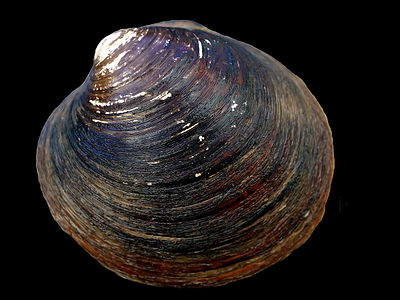Historical Geology/Sclerochronology
In this article we shall discuss the basis of sclerochronology, a method of dating shells and corals by analysis of their growth patterns.

Growth patterns in shells and corals
editWhen shelly organisms grow, many types lay down bands of new growth in a way that regularly reflects the passage of time: for example, laying down one growth band per day (as many corals do), or one growth band every low tide, as mussels do.
Some corals lay down distinct bands of skeletal calcium carbonate on a daily basis and also display seasonal patterns, so that they keep count both of days and of years. In the same way, mussels deposit their growth bands every low tide, but also show variations according to the phase of the moon, so that they keep count both of low tides and of lunar months. The photograph above right shows the clam Arctica islandica, a popular species with sclerochronologists: growth bands are visible in the shell.
It is possible to use these growth patterns to date recent shells (and so the sediments that contain them) in a manner analogous to dendrochronology. However, there is a more interesting way of using this data, which we shall discuss in the remainder of this article.
Tidal braking
editThe friction of the tides slows down the Earth's rotation: this is known as tidal braking. The effect, though small, is measurable by the high-precision clocks used by astronomers, and so can be established directly as well as on theoretical grounds: at present, the effect amounts to a day getting longer by 2.3 milliseconds over the course of a century (see here for more details). This may not sound like much, but it adds up: over the course of 100 million years, that would add up to a change in the length of a day of 38 minutes.
This means that in the past days must have been shorter. As the length of a year is constant, this means that in the past there must have been more days per year: using the present rate of slowing as a basis, there would have been about ten more days per year a 100 million years ago.
We should note that in fact scientists do not simply extrapolate the present rate of slowing in a linear manner to calculate past rates of rotation, but rather calculate this from the physics of the Earth-Moon system. For the purposes of this article, it is not necessary to go into the details of the calculation.
Tidal braking and sclerochronology
editThis immediately suggests a way of dating corals and shellfish. Take corals as an example. As I have said, they lay down daily bands, and the way in which they do so displays seasonal fluctuations. This means that by counting the number of daily bands per year, we can find out how many days there were per year at the time when they were formed. In the same way, by looking at mussels we can find out how many low tides there were per lunar month when they grew.
So by calculating how tidal braking has changed the number of days in a year or a lunar month, we can put a date on the organisms: for example, a coral showing 375 daily growth bands per year must have grown around 100 million years ago.
Weaknesses of the method
editThe number of days per year or per lunar month changes so slowly over time that we cannot expect sclerochronology to be as precise as radiometric methods such as U-Pb. If a change of one day per year corresponds to the passage of 10 million years, then this limits the precision with which we can resolve the age of a shell or coral.
What is more, the change in day length is not as predictable as the decay of radioactive isotopes. Although there is a general tendency for the Earth to slow down, occasionally it has sped up slightly, as we know from direct measurement.
Over the longer term, the magnitude of tidal braking will depend on the exact interaction of the Earth and Moon. Such things as the position of the continents and of mid-ocean ridges will affect tidal patterns, and these change over time as we have seen in our discussion of plate tectonics. Then again, the formation of polar ice-caps, and the concomitant fall of sea-levels would speed up the Earth's rotation as a consequence of the law of conservation of angular momentum.
Because of these considerations, geologists prefer to use radiometric methods rather than sclerochronology where it is possible to do so, even though radiometric dating is rather more expensive. However this sclerochronological technique, even if it is rarely used in practice, has a distinct theoretical significance: it acts as an check on the validity of radiometric methods. When we find approximately 400 days per year in the Devonian period and about 390 in the Carboniferous (see J. Wells (1963) Coral Growth and Geochronometry, Nature 197(4871), 948-950) then this is in line with the dates put on these periods by radiometric methods. Since the mechanisms of coral and shell growth are completely unrelated to the process of radioactive decay, this provides a completely independent check on radiometric dating. The agreement between sclerochronology and radiometric dating is therefore a good reason to have confidence in both.